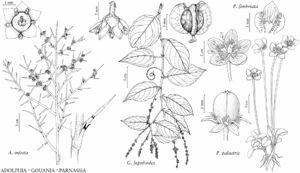Parnassia
Sp. Pl. 1: 273. 1753.
| Taxon | Illustrator ⠉ | |
|---|---|---|
 | Gouania lupuloides Adolphia infesta Parnassia palustris Parnassia fimbriata | Yevonn Wilson-Ramsey Yevonn Wilson-Ramsey |
Herbs, perennial with caudices or rarely rhizomes. Stems erect, unbranched scapelike. Leaves basal in rosettes or 1–2 per node on rhizomes (P. caroliniana) and cauline (0–) 1 [–8], alternate; stipules absent; petiole present in basal leaves, usually absent in cauline leaf; blade margins entire; venation palmate. Inflorescences terminal, flowers solitary. Flowers bisexual, radially symmetric or ± asymmetric; perianth and androecium hypogynous or perigynous; hypanthium absent or completely adnate to ovary; sepals 5, connate proximally; petals 5, white [yellowish] with distinct yellowish or greenish or gray-brown veins, 3–22 mm, usually longer than sepals; nectary absent; stamens 5; staminodes 5, opposite petals, usually deeply divided, sometimes undivided, gland-tipped or glandular at apex [without glands]; pistil [3–] 4 [–5] -carpellate; ovary superior to 1/2 inferior, 1-locular, placentation parietal; style absent or essentially so; stigmas [3–] 4 [–5]; ovules 100–2000+. Fruits capsules, 1-locular, [3–] 4 [–5] -valved, ellipsoid to globose, apex not beaked. Seeds 100–2000+ per fruit, oblong, winged; aril absent. x = 9.
Distribution
North America, Mexico, Europe, Asia, nw Africa
Discussion
Species ca. 70 (9 in the flora).
The North American species of Parnassia usually occur in moist to wet sites on neutral to base-rich substrates, but P. asarifolia often occurs on acidic substrates.
The treatment of Parnassia cirrata and P. fimbriata follows that proposed by R. B. Phillips (1980).
Selected References
Lower Taxa
Key
| 1 | Petal margins fimbriate proximally; cauline leaf usually on middle to distal 1/2 of stem, rarely absent. | > 2 |
| 2 | Staminodes irregularly divided into oblong, obtuse lobes, usually glandular at apex but tip not differentiated into distinct gland; sepal margins denticulate, erose, or short-fimbriate distally. | Parnassia fimbriata |
| 2 | Staminodes scalelike proximally, distally divided into gland-tipped filaments; sepal margins usually entire, rarely minutely denticulate distally. | Parnassia cirrata |
| 1 | Petal margins entire or undulate; cauline leaf usually on proximal 1/2 to middle of stem or absent, rarely on distal 1/2. | > 3 |
| 3 | Sepal margins not hyaline; staminodes unlobed or divided distally into 3–27 filaments. | > 4 |
| 4 | Petal lengths 1.5–2 times sepals; anthers 1.5–2.8 mm. | Parnassia palustris |
| 4 | Petal lengths 0.8–1.5 times sepals; anthers 0.7–1.6 mm. | > 5 |
| 5 | Petals 5–13-veined; staminodes with 5–7(–9) filaments; anthers 1–1.6 mm. | Parnassia parviflora |
| 5 | Petals usually 3-veined; staminodes unlobed or with 3–5 filaments; anthers 0.7–1 mm. | Parnassia kotzebuei |
| 3 | Sepal margins hyaline, mostly 0.2–0.5 mm wide; staminodes 3-fid almost to base. | > 6 |
| 6 | Leaf blades mostly wider than long; petal bases abruptly contracted to claw. | Parnassia asarifolia |
| 6 | Leaf blades longer than to ca. as long as wide; petal bases cuneate to rounded. | > 7 |
| 7 | Staminodes 4–7 mm, shorter than or ca. equaling stamens. | Parnassia glauca |
| 7 | Staminodes 9–16 mm, longer than stamens. | > 8 |
| 8 | Staminode glands elliptic to subglobose, 0.4–0.6 mm; plants with caudices; basal leaves in rosettes; ovaries green, sometimes whitish at base. | Parnassia grandifolia |
| 8 | Staminode glands lanceolate, 1–1.7 mm; plants with creeping rhizomes; basal leaves 1–2 per node on rhizomes; ovaries white. | Parnassia caroliniana |